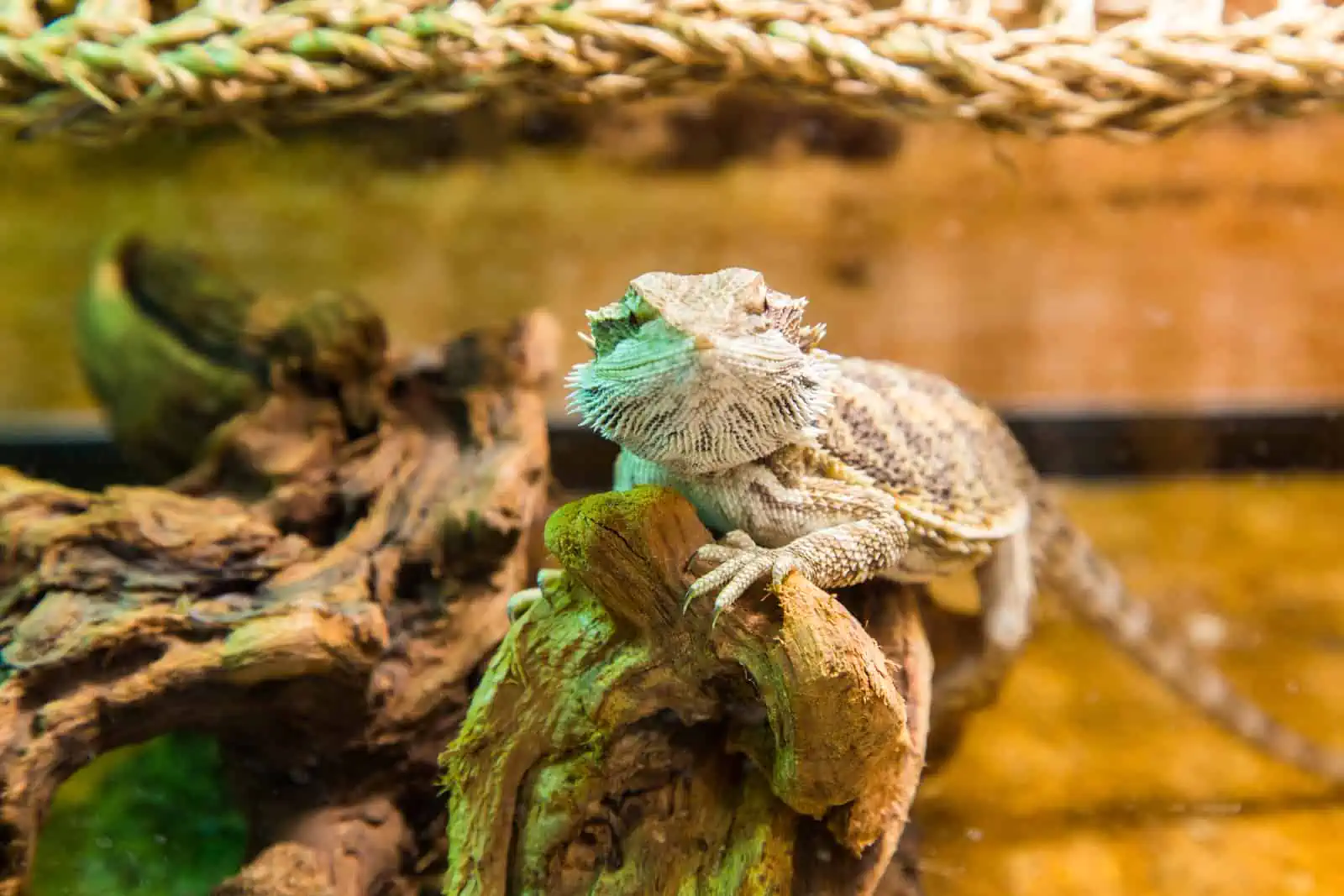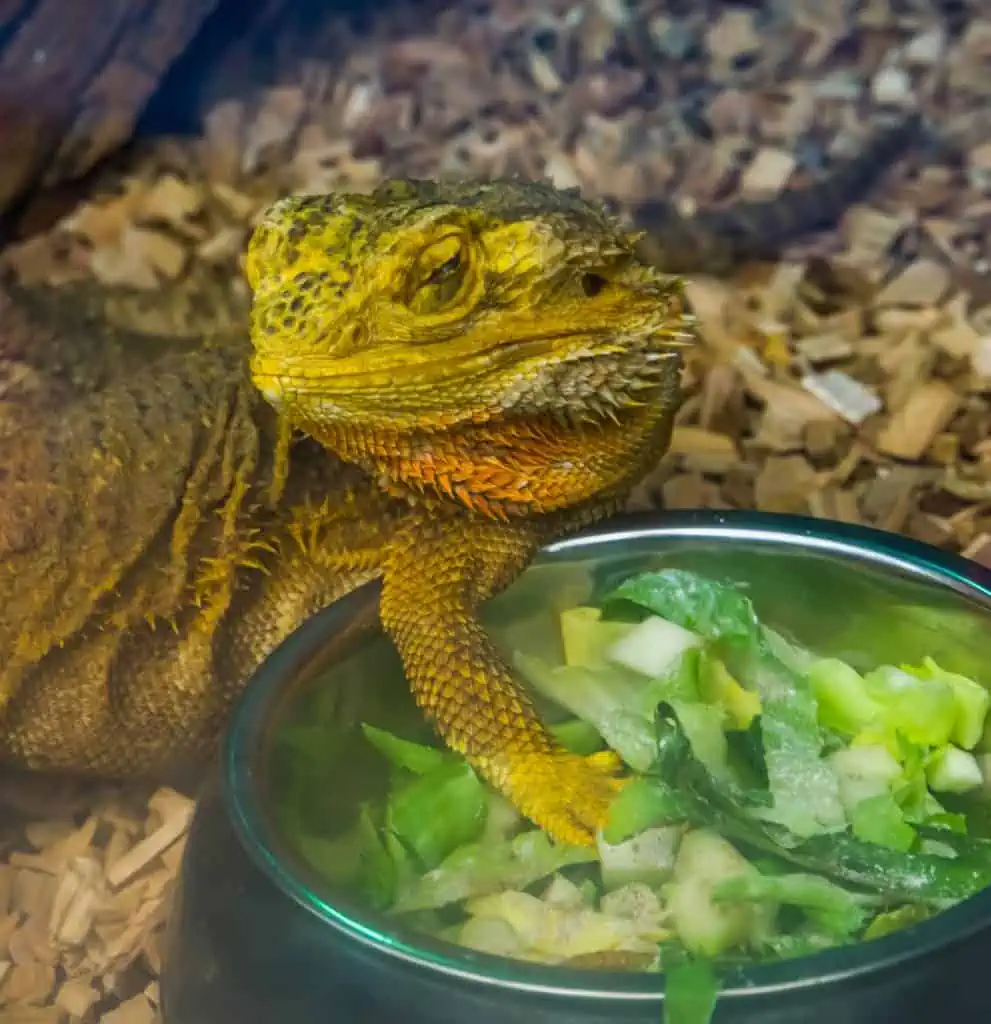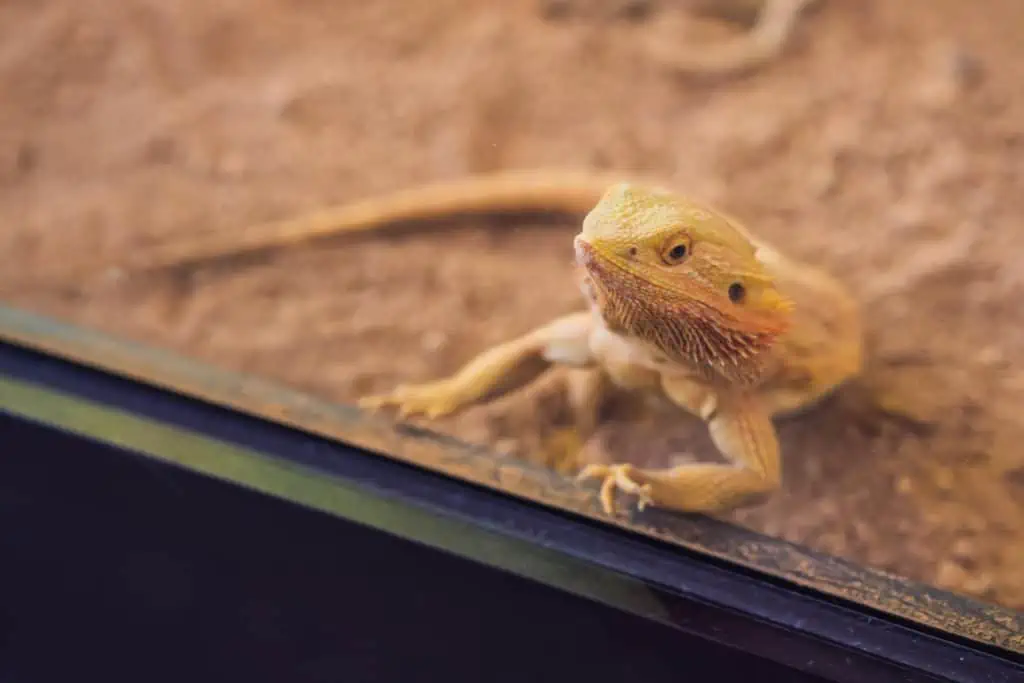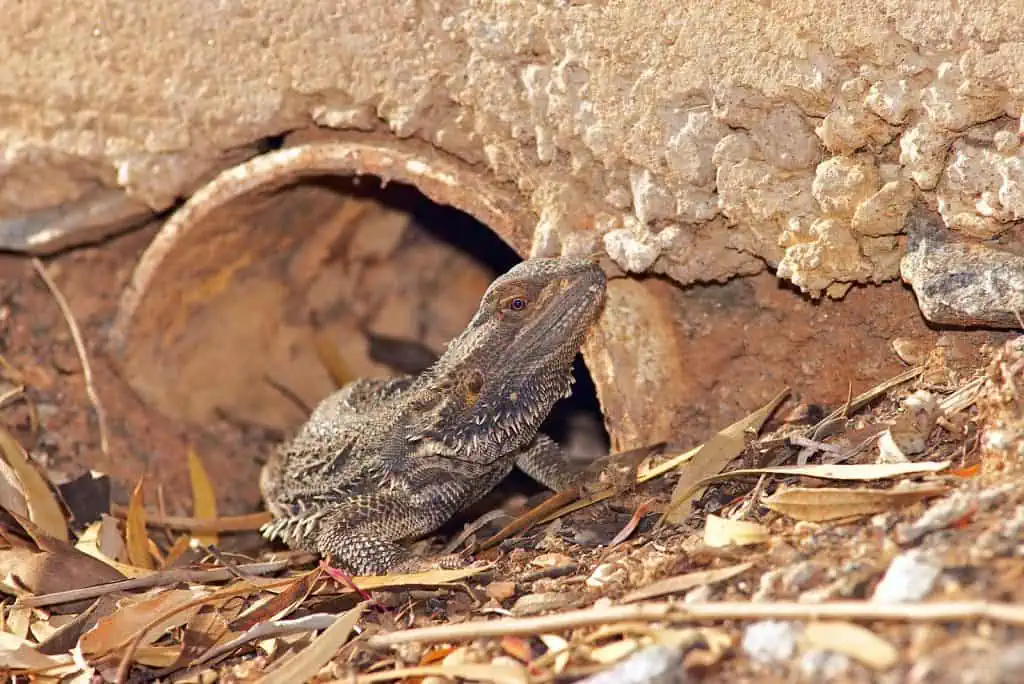Bearded dragons are adorable pet reptiles – beautiful, fun, can become tame, and are generally healthy and resilient.
Well, adorable in nearly all aspects – one may be slightly problematic.
When it comes to hygiene, popular beardies can be messy and, consequently, smelly. They have hefty appetites and fast metabolisms, meaning they poop constantly and everywhere. Also, they love to splash around in water if the bath is available, adding to the mess.
Let’s come clean – if you want to avoid bad smells and the risk of reptile infections, you’ll have to dedicate some extra energy to bearded dragon tank cleaning. Regularly cleaning your bearded dragon’s tank is crucial for their well-being and good health.
In this guide, you’ll find top advice on properly cleaning your bearded dragon’s tank to ensure a safe and comfortable living space for your pet.
The good news is that it’s not as hard as you might imagine – all you need are basic cleaning supplies and consistency.
What Do I Use to Clean a Bearded Dragon Tank?
You can’t do proper house cleaning without proper cleaning supplies – and that goes for bearded dragon homes as well.
However, you must never use regular home cleaning supplies for bearded dragon tanks due to dangers and potential adverse effects.
There is a limited list of cleaning chemicals for reptile enclosures, but the good news is they’re all readily available.
To fully understand reptile keeping hygiene, we need to distinguish between two terms – cleaning and disinfecting.
Cleaning vs. Disinfecting
Cleaning regards removing various organic debris and stains from the tank, such as poop, food debris, and dead plant matter. After you successfully complete cleaning, the tank will look visually clean.
However, cleaning the tank doesn’t mean you’ve removed all the dirt. At the microscopic level, bacteria and other disease-causing organisms can remain conspicuously stuck on various surfaces. That’s where disinfection comes in.
Disinfection means addressing the invisible threat – microorganisms and removing them as much as possible. For this task, you’ll rely on special chemical solutions that kill harmful microorganisms – disinfectants.
There are two levels of disinfection
- Sanitization – reducing the number of microbes to a safe level.
- Sterilization – removing or inactivating all microorganisms.
Efficient sanitization is usually enough for regular maintenance. You should aim for sterilization if your beardie has gotten sick, and its excrements are likely to contain pathogens.
Supplies for Cleaning Bearded Dragon Tank
Here is a list of basic supplies suitable for cleaning the bearded dragon tank.
- Disinfectant of your choice
- Spray bottles
- Cloths (microfiber is best; regular sponge should not be used multiple times)
- Paper towels or old newspaper
- Warm water
- Mild soap
- Bucket
- Gloves
Personal Protective Equipment when working with dangerous chemicals (e.g., bleach)
- Protective gloves
- N95 mask
- Protective glasses
List of Reptile-Friendly Disinfectants for Bearded Dragons
When it comes to disinfecting reptile tanks (and that most definitely includes beardies), you must choose products that are safe for reptiles. Decades of development and application have helped us know what’s best with more certainty.
Note that some disinfectants commonly used in the past, such as bleach and ammonia, are falling out of favor, mostly due to safety issues.
Here are a few safe disinfectants commonly used for reptile tanks and the reasons behind their suitability:
Chlorhexidine Solution
If you want a safe, easy, and stress-free product to clean and disinfect your beardie’s tank, consider trying a 2% Chlorhexidine Solution.
Chlorhexidine is a widely used disinfectant safe for use around animals and is commonly used in veterinary hospitals and zoos.
A great advantage of this cleaning solution is that, unlike others such as bleach, Chlorhexidine is non-toxic, non-irritating, and has no odor or fumes that can harm you or your animals. In fact, weaker (1%) Chlorhexidine solutions are used as antiseptics to irrigate wounds or as mouthwash. Two percent solution is most commonly used for tank disinfection.
The active ingredient, Chlorhexidine gluconate, kills many bacteria from Streptococcus, Staphylococcus, Escherichia, and Pseudomonas genera and sabotages their reproduction. Also, it is effective in neutralizing viruses and molds.
F10SC Veterinary Disinfectant
F10SC (or F10 for short) is an excellent veterinary disinfectant widely used in the reptile-keeping community. It has broad-spectrum antimicrobial properties, working against bacteria, viruses, fungi, and spores – and is one of the most effective products on the list.
F10SC is completely safe for reptiles, provided you use it according to instructions. Unlike other solutions, the F10 remains active, offering continuous residual protection even after cleaning. You can use it to disinfect pretty much anything in the tank, from bowls to toys to tank walls. There’s no need to rinse it off since it is non-toxic if ingested in small quantities.
Again, following the manufacturer’s instructions for dilution and contact time is highly important.
The tricky part is that F10 might be tricky to find and is more expensive than many other solutions on the list. Still, I believe it’s worth having around, especially if you’re an advanced hobbyist.
Cleaning Vinegar or White Vinegar
White vinegar or a vinegar-water solution can be used as a natural and safe disinfectant for reptile tanks. It is also superb at decalcification, literally melting away any white calcium buildup and allowing you to wipe it clean instead of doing heavy scrubbing.
Cleaning vinegar is a 6% concentration of the acid while cooking vinegar is 5%. It’s preferable to use cleaning vinegar for greater efficacy, although the difference is not that crucial.
However, vinegar has only mild antimicrobial properties. It can help you get rid of regular dirt, grime, and bad odor. However, it is usually not effective in dealing with more resistant pathogens.
Remember that the vinegar residues must be washed away since they irritate reptile skin and airwaves. Also, the acidic odor can be aggressive and sharp.
If undiluted vinegar is too strong for you, you might be happy to learn that it also works great when diluted with water in a 1:1 concentration (one part water, one part vinegar).
Flukers Super Scrub Brush
If you are looking for a user-friendly ally in spot cleaning, Fluker’s has something for you.
The Super Scrub Brush contains an enzymatic cleaning solution that degrades organic dirt and (surprise!) a brush at the top. You simply squeeze the bottle, the liquid pours out (quickly, so be mindful), and you scrub the surface with the brush.
The ease of use and effectiveness makes this product great to use when cleaning your beardie after they do the number two in the tank. The solution doesn’t need to be rinsed.
A word of caution – many customers warn that the bottle leaks easily in transport and if left horizontally. Thus, don’t be surprised if it arrives wet in the packaging bag, and always store it upright.
Steam
If you feel uneasy about storing or using any potent chemicals needed for disinfection, consider using steam cleaning. Getting a steam cleaner is an investment, but once you buy it, you’ll need only water for extremely efficient sterilization.
You simply direct the pressurized onto surfaces and into cracks, and it will kill most kinds of bacteria, viruses, molds, and parasites – even the coccidia oocysts at temperatures above 165 degrees F.
Just be careful not to direct the steam onto the cold glass, as it may crack.
Moderately Appropriate Cleaning Solutions
Some cleaning solutions used to be standard but are a bit outdated today – simply because nowadays, we have better and safer options.
Still, these products are cheap and widely available. You might find yourself having them at hand – so it’s better to know how to use them.
Diluted bleach
Due to its high effectiveness, availability, and budget price, bleach used to be one of the most common aquarium and terrarium disinfectants. In fact, many advanced reptile hobbyists and breeders still use it regularly – because if you have a lot of enclosures to clean weekly, the price adds up.
The 10% solution (1:10) of bleach can be used for general disinfection of the enclosure and its non-absorbent elements. It destroys most bacteria, viruses, molds, mycoplasmas algae, and mycoplasmas and neutralizes nasty odors efficiently. However, it is not efficient against coccidia. Ensure contact time of 10 to 15 minutes and rinse thoroughly and carefully.
!! Bleach Warning !!
Unlike previously listed cleaning solutions, bleach can be toxic, dangerous, and even deadly if used incautiously. Please only use it with proper personal protection equipment. In case you are a child, ask adults for help.
If it comes into contact with soft tissues, bleach causes irritation and burns. It can also produce irritating fumes that can cause skin and eye issues and even chemical pneumonia. It corrodes metals and damages clothing. Also, bleach should never come into contact with ammonia, as the reaction creates toxic fumes.
Alcohol
Alcohol is common in households and can be used to wipe surfaces to clean them quickly. Still, note that most homes have rubbing alcohol (70% solution), and higher concentrations (90%) are being required definite sterilization.
Otherwise, rubbing alcohol can be used as a quick sanitizer for wiping surfaces that don’t contain pathogens. You may need to wipe it several times since it evaporates quickly. Just to be safe, rinse after evaporation.
Inappropriate Cleaning Solutions – What NOT to Use to Clean Bearded Dragon Enclosures
Ammonia
Ammonia was once a common household cleaner and was also used for cleaning tanks for its effectiveness.
Truth be told, ammonia is highly effective against most pathogens, including the notorious though Coccidia, Cryitposporida, and mycobacteria.
However, experts advise against it today when other, better cleaners are available. Why? It smells bad and creates strong fumes, and any residues can be toxic to reptiles and cause respiratory and skin issues. To make things worse, it is hard to rinse off completely.
If you have no other option but to use ammonia, apply a 10% solution for 30 minutes.
Household Cleaning Products
Common household products are packed with various synthetic chemicals that can be harmful to your beardie short-term or long-term. We’re not even sure they’re completely safe for humans!
This may seem like a no-brainer. However, I have to point it out because I’ve seen reptile enclosure cleaning tutorials recommending using glass cleaners inside the enclosures – don’t do it.
How to Clean Bearded Dragon Tank – Step By Step Guide
As you’ve probably already learned, it is best to use modern veterinary disinfectants when cleaning your reptile tank. These products are designed to be safe for reptiles when used as directed and are also easy to use.
In the case of emergency, you can use the moderately appropriate but still tried-and-tested cleaning agents such as bleach and others – just make super-sure that concentrations are right. However, leaving the tank dirty for the time being is better than using inappropriate cleaning solutions.
If you run out of supplies, continue with spot cleaning and use mild soap and safe household items such as white vinegar until you get the right products.
As I said before, cleaning out the bearded dragon tank becomes much less stressful if you have a routine and a schedule.
It’s best to have separate routines for daily (spot) and deep cleaning.
Bearded Dragon Spot Cleaning Routine
- Look around the tank and identify the amount and the type of mess; grab adequate supplies accordingly.
- Start cleaning everything you see without making any major rearrangements.
- Remove poop, food bits, and any other organic material. Use adequate spot cleaners to get the hardened stuff.
- Repeat. Every day is ideal.
As for spot-use of disinfectants, use solutions that don’t need to be rinsed afterward – like Cloradexine or F10SC. Also, as I already pointed out, ready-made commercial reptile cleaning products can be an effective ally in daily spot cleaning.
Bearded Dragon Tank Deep Cleaning Routine – 10 Steps
Deep cleaning of the tank means you clean and disinfect everything – substrate, props, decoration, and tank glass. By doing this, you avoid harboring bad smells and the proliferation of pathogens in the “forgotten” corners of the tank.
Deep cleaning is time-consuming, sometimes tedious work. However, it’s in the best interest of your pet dragon and, therefore, a mandatory task. If it seems too much of a drag to do this at least every other week, perhaps you should consider another reptile.
Here are the 10 steps to take to deep-clean your beardie’s enclosure.
1. Remove your beardie from the enclosure and empty the tank.
Never do any thorough cleaning with your beardie in the enclosure. Move your precious lizard to a secure spot (a spare tank is best) until you’ve fully cleaned the enclosure.
Remove all decorations and reptile accessories from the tank. Then, take out the substrate if it is time to change it (depending on the type of substrate).
2. Pre-clean
Remove any large particles of dirt, debris, and waste from the tank. If it’s easier for you, you can also scrub some hardened grime at this point in the same way you would do spot cleaning. Also, dilute the reptile-safe disinfectant of your choice according to the instructions provided by the manufacturer. It is better to prepare the solution now than in the midst of serious cleaning.
3. Apply the disinfectant and clean the tank.
Spray the solution on the tank surfaces, including the walls, floor, and other areas needing cleaning. Use a cloth, sponge, or spray bottle to distribute the disinfectant evenly. Pay special attention to the corners, crevices, and any other hard-to-reach areas where waste may accumulate.
4. Let it sit.
Allow the disinfectant to sit on the surfaces for the recommended contact time specified by the manufacturer. This ensures that the disinfectant effectively kills any pathogens present.
5. Clean the decoration and accessories.
While the disinfectant does its magic in the tank, start cleaning the tank decorations and accessories using the appropriate method based on their material. Note that this can take a while, so you’ll likely have to take a break to finish the tank and then return to cleaning the props.
You can use warm water and mild dish soap, followed by thorough rinsing for non-porous and non-soiled items such as food and water bowls. If the situation with the item includes poop, scrub using a disinfectant, or wash and scrub as previously described, spray the disinfectant and let it sit.
For porous items like wood and certain types of rocks, you can wash them for cleaning and cook or bake them for sterilization. Some sources recommend changing these completely, as they can absorb grime and bacterial film, becoming difficult to sanitize completely. Still, trying to sanitize it makes perfect sense if you have a really decorative and perhaps expensive piece of wood.
6. Rinse thoroughly.
Back to the tank. After the contact time has gone by, rinse the tank thoroughly with clean water to remove any residue of the disinfectant. Also, rinse all the decorations and equipment.
Ensure that all traces of the disinfectant are washed away, especially if using bleach, vinegar, peroxide, or similar potentially irritating solutions. You don’t need to be as careful if using chlorhexidine or F10SC.
7. Dry the tank.
Completely dry the tank before reintroducing your reptile. Moisture can promote bacteria or mold growth, so it’s crucial to thoroughly dry the tank. You can use paper towels to speed up the process.
Porous items will take longer to dry. Put them out in the sun for faster drying and additional UV sterilization.
8. Put the substrate in.
Whether you are using a new substrate or returning the old one, now is the time to put it back in. This is a straightforward task. If you have a reptile carpet, cleaning is a more tedious task than with other types of substrates.
Since lizards, including bearded dragons, are territorial creatures, I like to do the following thing to make them more comfy. Save a little bit of old substrate and put it in the corner of the tank. That way, they won’t be taken aback by the hostile new smell of the enclosure – it will smell “like home” at least a little bit.
Note that your beardie needs to be fully healthy and parasite-free for this to be safe.
9. Get the equipment running again.
Re-install the thermometer and/or the thermostat. Turn on the lights and the heat source, ensuring that the temperature is correct before you put your beardie back in.
10. Reintroduce your bearded dragon.
After the tank is dry, all accessories are back in place, and the temperature is proper, carefully return your bearded dragon to its clean and refreshed habitat. Monitor their behavior to ensure they are comfortable and adjust the lighting and heating setup as needed.
How Often Do You Clean a Bearded Dragon Tank?
Spot cleaning: every day or every other day. Aim for every day, but if you miss one – don’t sweat it. However, be aware that the more you do the spot cleaning, the more you need to invest in the deep cleaning.
Deep cleaning: every week or every other week. Assess the need for deep cleaning by looking around and smelling the inside of the tank. If you have a reptile carpet, cleaning or weekly changing it is a must since it is notorious for harboring bacteria and bad odors.
Finally, if your beardie has been sick recently, deep clean and fully sterilize the tank while he’s still at the vet or quarantined. Never return a sick or treated lizard to a dirty enclosure.
Cleaning Bioactive Bearded Dragon Tanks
Bioactive tanks require more spot cleaning and less deep cleaning (deep cleaning a bioactive tank can get quite complex).
Besides being highly decorative, an important upside of bioactive tanks is that they are self-cleaning for the most part. However, the bad news is that creating long-term effective arid bioactive habitats is very hard, if not impossible.
Most organisms we use as “maintenance guys” in bioactive tanks – such as Collembola “snow fleas” and isopods prefer humid tank conditions. They can’t last for long, let alone reproduce in arid environments.
If you’re planning a bioactive or a naturalistic setup for your bearded dragon, do spot cleaning meticulously and prepare for long deep cleaning sessions as needed.
How Often Should I Change My Bearded Dragon’s Substrate?
When it comes to loose substrates for beardies, there are ways to sanitize them – bake for 15-20 minutes at 300-350 degrees F. However, let’s be honest – it is much easier to replace the substrate entirely. Still, the practice can get costly if you plan on changing it every two weeks.
Reptile carpet is best vacuumed and washed in the washing machine or replaced.
Non-porous, hard substrates like tile or slate are the easiest to disinfect.
How Do You Get Rid of the Bearded Dragon Smell?
Reptile bodies don’t have a particular natural odor. However, sometimes your beardie will get all dirty and smelly. This is especially true if you got yourself a “poop painter,” as this beardie forum brilliantly calls individuals who often run through their poo and make a mess.
The main way to prevent your beardie from getting too filthy too often is to prevent him from moving through his own feces. You can do that through the diligent daily spot-cleaning routine.
Installing the resting spots at a higher elevation also helps since your pet will usually “use the restroom” somewhere on the tank’s floor.
Bearded Dragon Bathing
Sometimes your pet dragon himself will need a deep wash!
Here is how you bathe a bearded dragon:
If you’ve never taken your beardie for a bath, it is important for you to know that it can die if it inhales water during bathing for a bath – here’s more detailed information.
Take Care!
Beardies are on the messier end of the spectrum regarding hygiene. They eat a lot, poop a lot (and everywhere), and splash around. That’s the reality.
To avoid bad smells and potential infections, do spot cleaning of organic matter such as feces, food scraps, and dead insects daily. Every week or two, plan for deep cleaning of the entire tank.
When it comes to reptile-friendly cleaning solutions, there are several great options out there – the choice is yours. Also, thoroughly rinsing and thoroughly drying of the tank are crucial steps before reintroducing your reptile back into their home.
Last but not least, always follow the instructions provided by the disinfectant’s manufacturer; use protective equipment and ensure ventilation when working with cleaning products to ensure your and your pet’s safety.





